The rise of fascism
At the turn of the twentieth century, various philosophical and political ideas were popular in the circles of a new generation of young European intellectuals. There were those who advocated a merciless class struggle, others had in mind the unification of their own nation, and still others were particularly attracted to the concept of a “superman”.
One of them was Benito Mussolini, a young, charismatic Italian journalist who, due to his rebellious nature, was a frequent visitor to Italian prisons. With all his youthful curiosity, he read, …no…, simply “swallowed” and translated modern philosophical literature, absorbing the ideas of Nietzsche, Engels, Marx, Malatesta, Pareto, and other stars of the intellectual climate of the time, whose thoughts fought for supremacy in the deeper spheres of his personality. One moment he would be a socialist, then a patriot; a pacifist, then a warmonger; a Bolshevik, then a nationalist. Various ideas were mixed in it, but it still took time to combine them into some kind of consistent system. Like many other rebellious contemporaries, he consciously avoided the idea of liberal democracy, which he considered decadent, “rotten” and outdated.
Towards the end of the First World War or immediately after it, finally, in the head of that Italian journalist, the collectivist ideas of nationalism and socialism were arranged in order of importance and tied into a unified, explosive combination whose fatal appeal would far exceed Italian borders. That ideology, which Mussolini called fascism, will drag Italy into the bittersweet hell of totalitarianism, and will bring glory, power and worship to him personally. The unity and pride of the nation should be
the highest goal, the class struggle will be replaced by cooperation between classes, and the nation should be led by a tireless and versatile leader – il Duce. In order to fulfill the historical task, the new Caesar had to work hard and the public had the honor of following him every day as he drives an airplane, participates in car races, rides horses, tames lions, plays the violin, swordsmanship, skiing, swimming, speaks all languages and has many mistresses. “Unfortunately, I am not such a superman as Mussolini” – lamented Mahatma Gandhi. That concept has been imitated many times, up to the present day, but the original personality cult, Mussolini’s patent. There have been larger, longer-lasting and more sinister cults since, but the widespread honesty and comprehensiveness of this original remains unsurpassed.
By that time, Mussolini had already learned that he should adapt the ideology to the lower, poorly educated, frustrated layers of society, that part of the social elite should be bribed, and the rest should be marginalized or silenced. As part of those efforts, the former ardent atheist reconciled with the church and remarried in a church ritual. As expected, the opposition was beaten and intimidated, and one opposition politician was even killed. The media were under tight control, and the elections, while they still existed, were unequal. Despite this, many people in Italy supported him. Marconi, Pirandello and D’Annunzio, among others, disgraced themselves by supporting the fascist government, and Filippo Marinetti and the entire Futurist art movement collectively joined fascism. When Mussolini asked Italians to hand over their gold items to the state as development aid, they did so en masse. Luigi Pirandello, for example, had his Nobel Prize medal melted down. Women took off and gave away their wedding rings, and dozens, probably hundreds, gave their leader and everything else a woman can give to an adoring alpha male.
Of course, not everyone was thrilled. At the height of his madness, a science fiction writer correctly predicted that Mussolini would someday declare war on France, that the war would be lost, and that he would then be killed by his own people. That’s how it happened,…but it will only happen later, and until then it was necessary to endure a few more years of his unbearable triumph. After all, “it is better to live one day as a lion than one hundred years as a sheep”, says Benito Mussolini.
Art and architecture in the age of fascism
Although during the fascist rule, Italian art was under state control and in the function of a great national goal, the restraint of the government was not yet as strict as in the later totalitarian regimes. Jazz, that “terrible Negro” music, was even a secret favorite, to the undisguised disgust of Mussolini’s fellow dictators, Hitler and Stalin. Moreover, one of Mussolini’s sons later became a leading jazz musician in post-war Italy and achieved significant international acclaim.
career. His second son was an important film critic and producer during the Fascist regime and decisively helped film directors Fellini, Antonioni and Rossellini at the beginning of their magnificent careers. The third son became a skilled pilot, and the fourth, the unrecognized one, was killed by the secret service.
“Degenerate” art, abstract, surrealist and expressionist, which was so fiercely ridiculed in Nazi Germany, was tolerated in Italy for a long time, and Marinetti’s Futurists were one of the vanguard of the new fascist art, although, unfortunately, they , were too international, instead of being specifically Italian. Their competition was formed by Margherita Sarfatti, an influential art critic and Mussolini’s Jewish lover, who gathered a group of fine artists ready to reinterpret the tradition of famous Italian painting and
at the same time, they make a more direct contribution to fascist propaganda. That movement was aptly called the Novecento Italiano. Even more directly in the service of the government were the authors of propaganda murals, facade reliefs and monuments with Duce’s image and fascist symbols, many of which are still visible today in Rome and other Italian cities.
The architecture of the initial period of fascist rule was marked by members of the rationalist artistic direction. The Rationalists, a group of young architects from the north of Italy, announced that their style would be something between Novecento and Futurism. “Something in between” is never a good idea for an art direction, but their proclamation wasn’t actually the whole truth. They were, in fact, typical representatives of what would be known in architecture as Modern, that is, in America as the “international style”. At that moment, the pendulum of artistic taste had already shifted from emphatic decoration to utilitarianism, rationality and the absence of any decoration. The architect Giuseppe Terragni stood out in particular, and his most famous rationalist work is the Casa del Fascio in the city of Como, in the far north of Italy, along the border with Switzerland. When, on the last day of his life, the persecuted Benito Mussolini tries to reach the Swiss border or at least the American army to surrender to it, his escape route will lead him through Como. Did he take the opportunity to take one last look
towards that object and allow himself to be overwhelmed by the feeling of the transience of life?
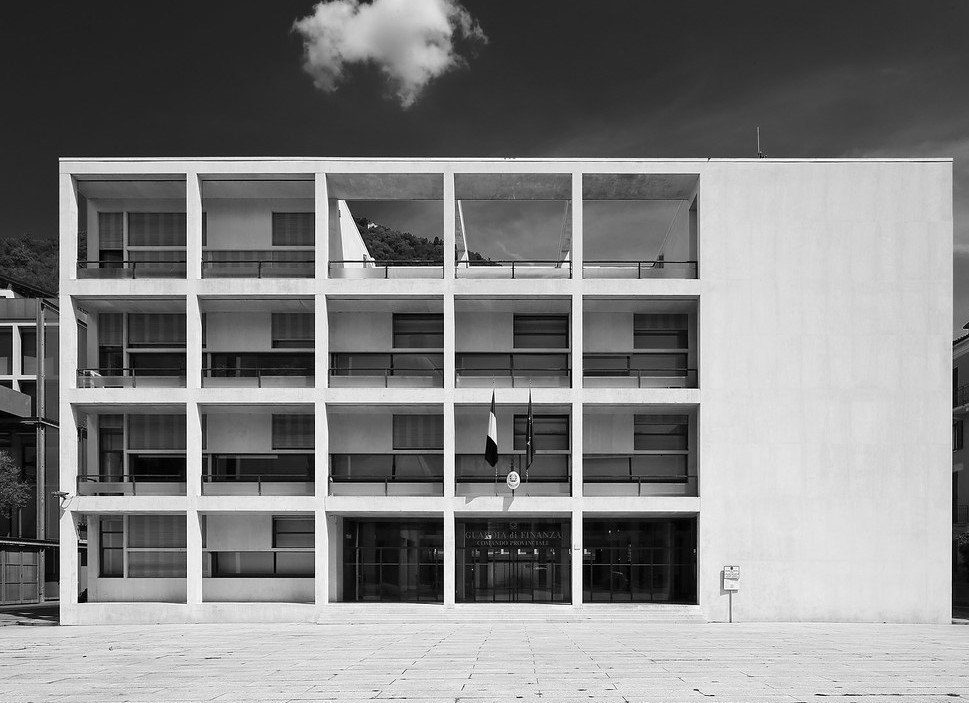
Casa del Fascio is actually a general name for the local headquarters of the Fascist party and many, probably thousands, were built all over Italy, many of them in the very style of Rationalism. Today’s visitor to the city of Como has every chance not to notice that building at all, because what characterizes it was later reproduced many times, especially in Eastern Europe, so its appearance is not interesting enough to attract attention. Even today, the building stands relatively unnoticed in Como, with the flags of Italy and the European Union on it, so it is probably now a municipal building.
It wasn’t bad, but the new government needed something even better. The first obvious problem is that this Italian rationalism was not even a pale shadow of what was happening at the time in the architecture of democratic, liberal, hated America. The second, even more important, was the lack of specific Italian motifs, so even the moderate supporters of tradition got their chance.
Newly founded ideal fascist cities
The architecture of Italian fascism had one very important area in which it could excel. They were newly founded towns and villages, which had to be given a specific modern, national, fascist character. Although there were cases that they were founded for other reasons, the most characteristic were those cities that were founded on land obtained by draining ancient swamps. Namely, in the sea of demagoguery that characterized Mussolini’s fascist
government, there were also some concrete successes, and particularly striking was the draining of the Pontic marsh, south of Rome, which had been a breeding ground for malaria since time immemorial. Drainage began as early as the Renaissance, but it was only successfully completed in the 1930s and the marshland was transformed into high-quality agricultural land interspersed with canals and roads. In that area, the planned construction of towns and villages and the settlement of people from other parts of Italy began. The urban concept was quite clear. In the center there will always be a square with a church, the Casa del Fascio, a school, a municipality and a police station, and in the surrounding regular streets there will be residential houses for the predominantly agricultural population.
The main architectural battle, often on the verge of scandal, was fought over the design of the central buildings in these newly formed places. The representatives of the leading architectural styles, Novecent and Rationalism, accused each other very bitterly. Even when tenders were announced for the projects, they were of dubious regularity and were always accompanied by accusations, insults and controversies. Basically, it was always about how much should be modern and how much should be traditional. In the end, rationalists, novecentists and futurists also got their share of the cake, and the most successful in getting lucrative jobs was the modernist architect Concezio Petrucci, a personal friend of the Minister of Public Works, who always easily won controversial competitions, sometimes with some very interesting projects.
In Sardinia, which also suffered from endemic malaria, a similar program of draining the swamps was launched, which during the time of Mussolini was only partially successful, but even this was enough for three Sardinian towns to be founded in that period in typical fascist fashion: Mussolini (today Arborea), Carbonia and Fertilia.
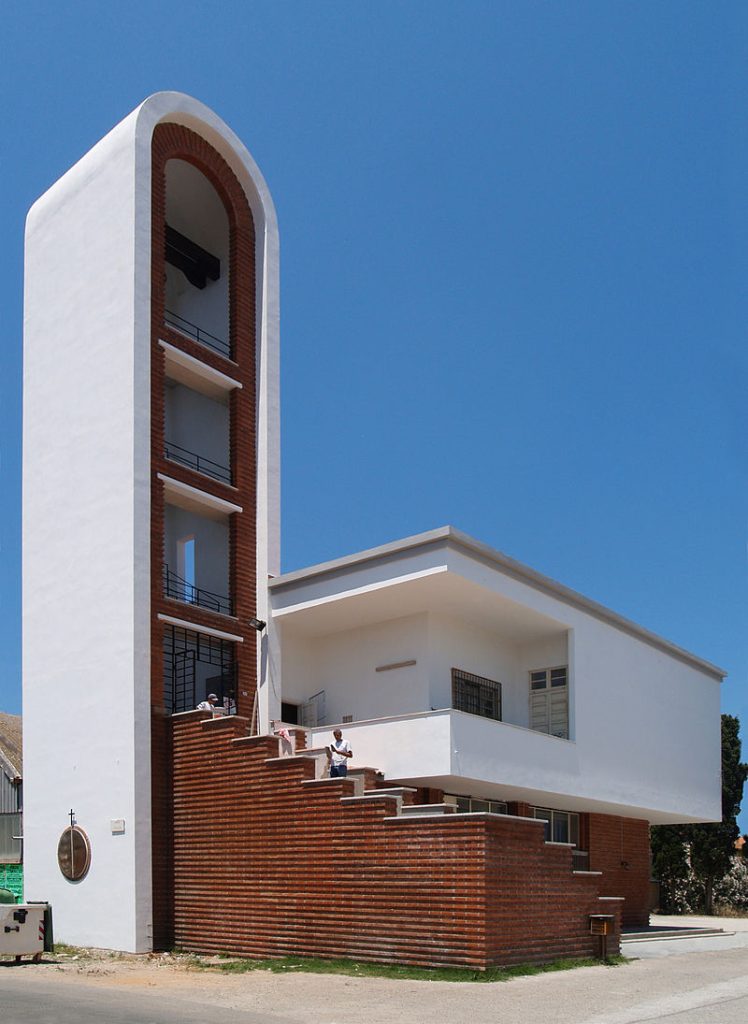
At the competition for the Fertilie project, Petrucci and his collaborators won again, although the urban solution, based on the British garden city concept, was given earlier by engineer Arturo Miraglia. The war hindered construction and settlement, so until the end of the war the buildings were unfinished and empty, and they were completed only after the war, when refugees from Istria, Rijeka and Dalmatia who were expelled by Yugoslav partisans settled in Fertilio.
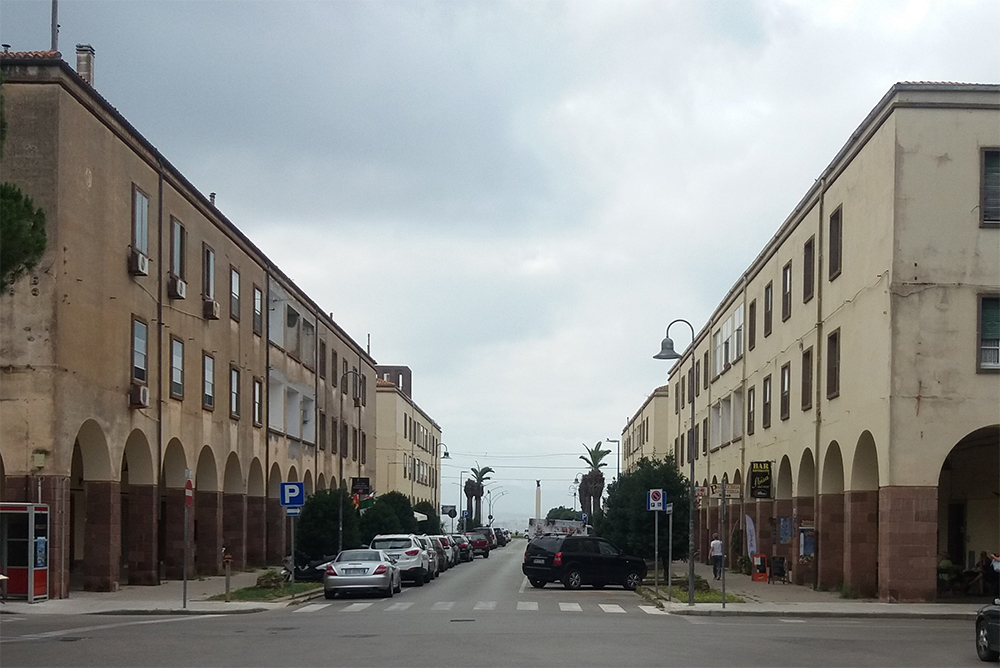
Their descendants still live in that place, whose streets bear nostalgic names from the old region:
Via Fiume (Rijeka), Via Zara (Zadar), Via Cherso (Cres), Via Parenzo (Poreč), Lungomare Rovigno (Rovinj Promenade), Via Dalmazia…. In the center of the town there is a restaurant, whose owner escaped from Rovinj and where, to this day, an Istrian dinner is prepared every Wednesday.
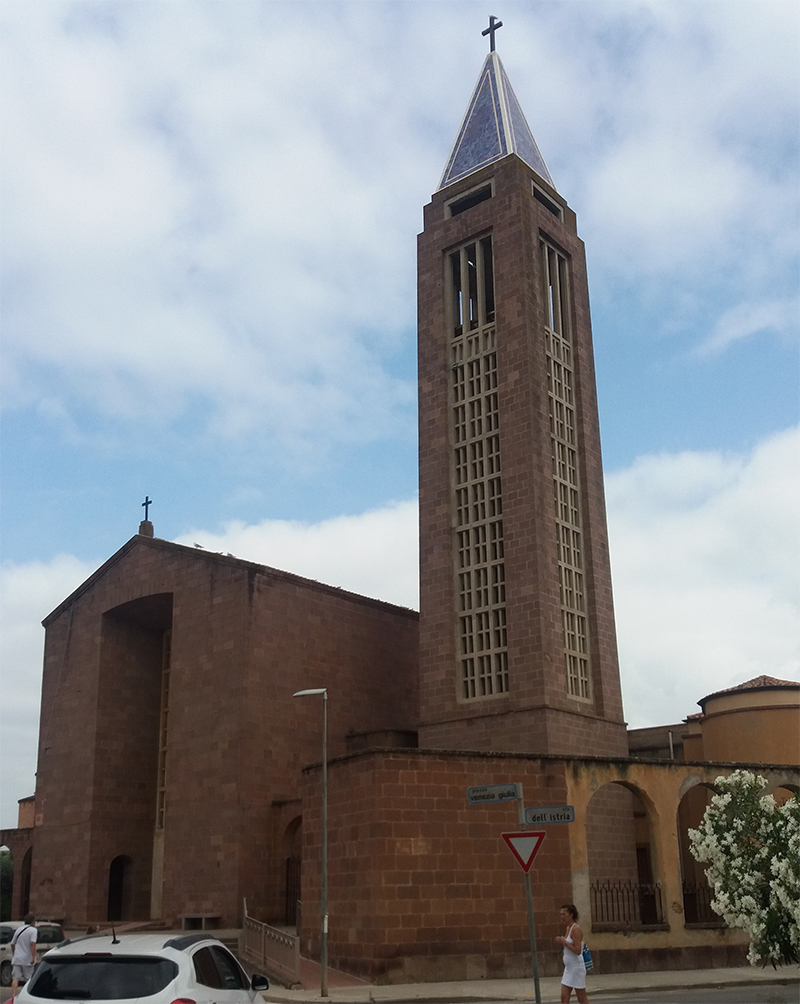
When, after the war, as part of the Marshall Plan, with the support of the Rockefeller Foundation, Sardinia was finally freed from malaria, its tourist development began from the city of Alghero, a small Barcelona, a Catalan enclave in Sardinia, located just a few kilometers from Fertilia. Although Alghero is full of tourists in the summer, Fertilia is still half-empty, sleepy, hopelessly nostalgic. The initial idea of the garden city was not fully implemented.
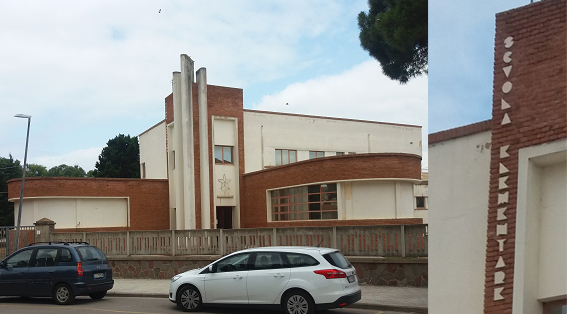
EUR district in Rome
The most ambitious architectural project in Fascist Italy was the construction of the EUR district in the southern part of Rome, which was built for the needs of the world exhibition, Esposizione Universale Roma, EUR for short, which was to be held in 1942. It would have been an ideal opportunity for Mussolini to celebrate the twentieth anniversary of Fascism. authorities and show the achievements of his country. By the time that project appeared, Mussolini was no longer the lone eccentric at the top of the political scene in Europe. His great admirer, the German National Socialist Adolf Hitler, was now his rival. It was necessary to show Hitler and the rotten West who was still in charge.
It was, of course, not a project on which some rationalists or futurists should be allowed to compete, so Mussolini chose the best man he had available – Marcello Piacentini – as the chief designer, with all the powers.
Piacentini was an architect with a wealth of experience, who had gone through everything and anything in his career, and in the era of fascism he was very good at combining modern and traditional architectural expressions. Under the pressure of great national importance, and especially competition from Germany, in this project he had to add a large dose of monumentality, with an emphasis on the use of ancient Roman motifs, which was a growing trend in the last years of fascist rule.
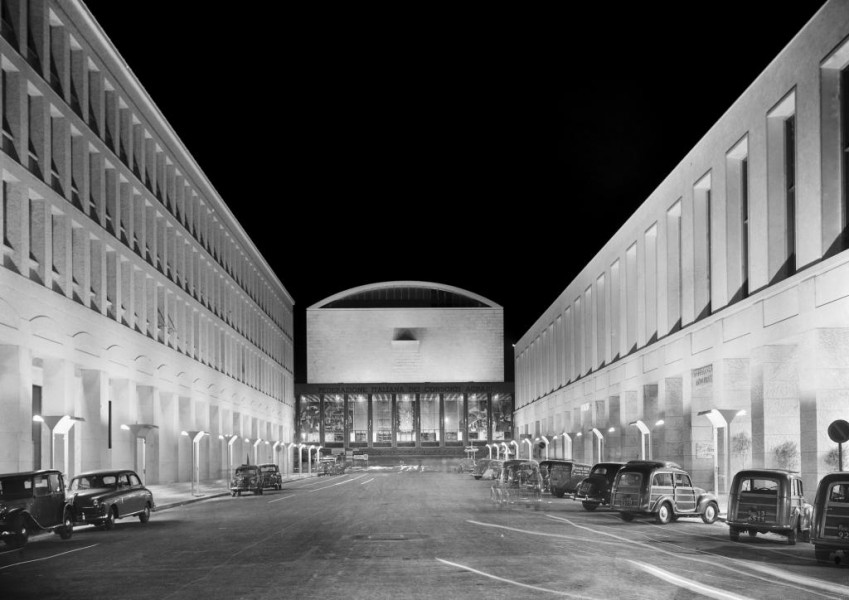
EUR was conceived as a city district with public buildings, a congress center, a large sports hall, an artificial lake and wide boulevards, dominated by neo-antique statues and colonnades. Most of the buildings in that district, whose monumentality emphasized the importance of the moment, lost their initial excitement over time, so they are less interesting today, but one of them changed the perception of the entire district with its appearance. It is a building called the Palace of Italian Civilization, which some call the Square Colosseum.
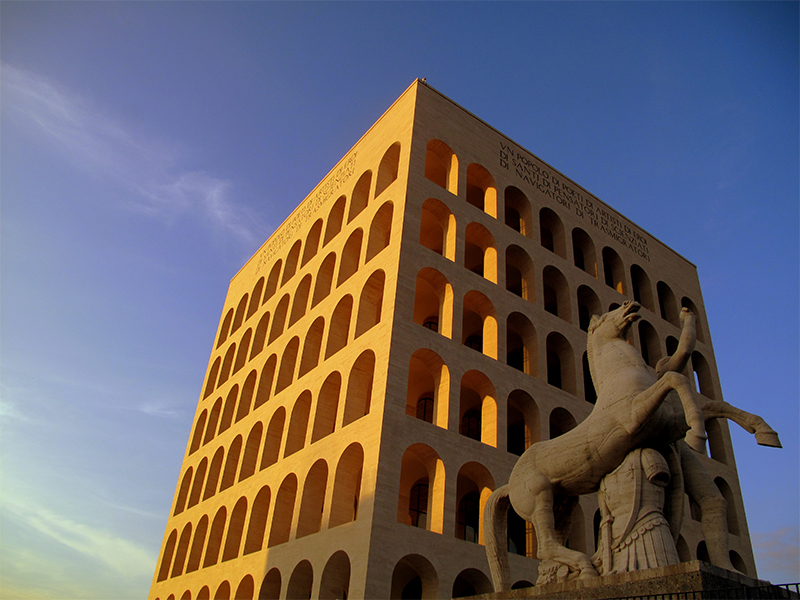
Palace of Italian civilization
Probably, following the reinterpretation of Antiquity, the basic idea really was to place the series of arches on the facade that adorn the ancient Coliseum, on a building of a different shape. However, when this was carried out and neo-antique statues were added to the arches on the ground floor, a building was obtained that seemed to be out of this world, that seemed to be of no use and through which a wind of deep nostalgia seemed to blow eternally. An empty plateau around the building, ancient statues instead of people, a building that
it does not serve anything, … it is no wonder that many in that place feel as if they have fallen into some “metaphysical” image of Giorgio di Chirico and that is the changed perception of the whole district

All four facades are the same, on the upper part of the facade there is a quote about Italian culture from one of Mussolini’s speeches. On each of the facades, the arches are arranged in a matrix of six types and nine columns. Some say that this is because the word Benito has six letters and Mussolini has nine, but these are just guesses. No one knows for sure what were the artistic intentions of the object’s authors, Guerrini, Lapadula and Romano, and what happened unplanned.
Although the World Exhibition was not held due to the war, the EUR was built, heavily bombed, and then rebuilt after the war, partly according to the original designs, and partly in accordance with post-war trends. The main architect, Piacentini, whom the public associated with the former regime, was marginalized in the post-war period and for some time did not receive serious projects, but only taught at the university. However, when the renewal of the EUR was in full swing, he was invited to make his contribution.
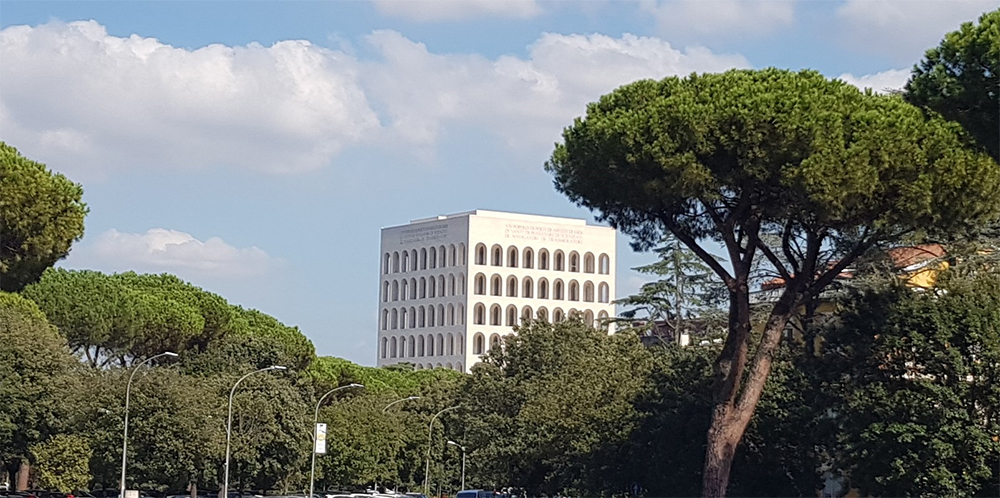
Today’s EUR is a modern business zone moved from the city center, where large international companies have their offices. The Palace of Italian Civilization is rented by “Fendi”, a manufacturer of luxury fashion goods.
Darko Veselinović, February 2020.

